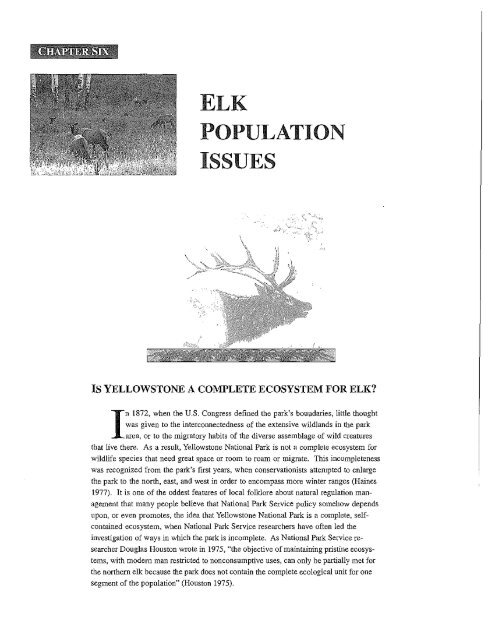Yellowstone's Northern Range - Greater Yellowstone Science ...
Yellowstone's Northern Range - Greater Yellowstone Science ...
Yellowstone's Northern Range - Greater Yellowstone Science ...
You also want an ePaper? Increase the reach of your titles
YUMPU automatically turns print PDFs into web optimized ePapers that Google loves.
ELK<br />
POPULATION<br />
ISSUES<br />
IS YELLOWSTONE A COMPLETE ECOSYSTEM FOR ELK?<br />
In 1872, when the U.S. Congress defined the park's boundaries, little thought<br />
was given to the interconnectedness of the extensive wildlands in the park<br />
area, or to the migratory habits of the diverse assemblage of wild creatures<br />
that live there. As a result, <strong>Yellowstone</strong> National Park is not a complete ecosystem for<br />
wildlife species that need great space or room to roam or migrate. This incompleteness<br />
was recognized from the park's first years, when conservationists attempted to enlarge<br />
the park to the north, east, and west in order to encompass more winter ranges (Haines<br />
1977). It is one of the oddest features of local folklore about natural regulation management<br />
that many people believe that National Park Service policy somehow depends<br />
upon, or even promotes, the idea that <strong>Yellowstone</strong> National Park is a complete, selfcontained<br />
ecosystem, when National Park Service researchers have often led the<br />
investigation of ways in which the park is incomplete. As National Park Service researcher<br />
Douglas Houston wrote in 1975, "the objective of maintaining pristine ecosystems,<br />
with modern man restricted to nonconsumptive uses, can only be partially met for<br />
the northern elk because the park does not contain the complete ecological unit for one<br />
segment of the population" (Houston 1975).















